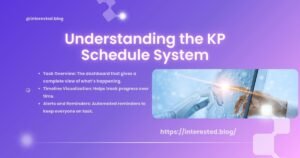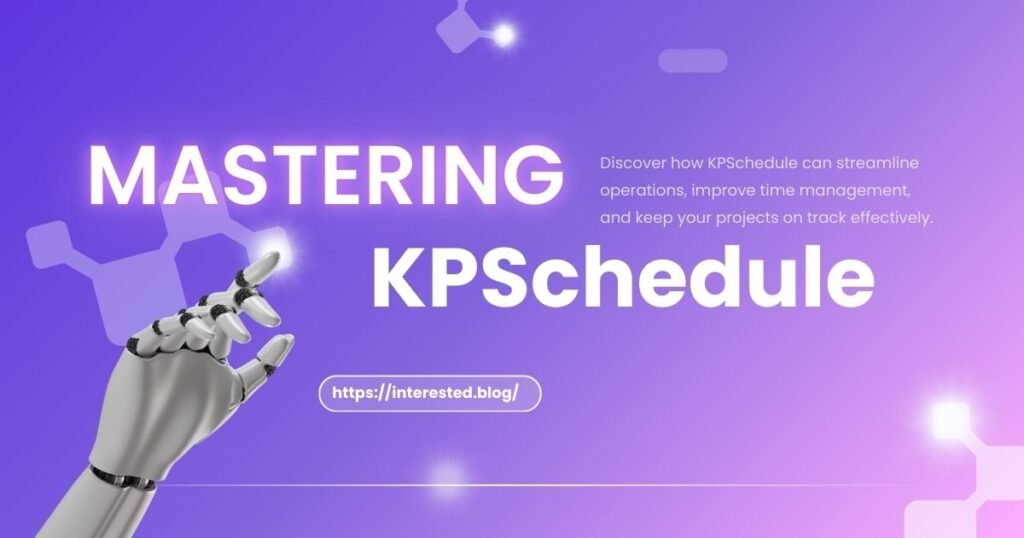Introduction
In today’s fast-paced work environment, organizations need tools and systems that help streamline operations, manage time effectively, and keep projects on track. One such tool gaining popularity is the KPSchedule.
What is KP Schedule?
The KP Schedule is a strategic scheduling tool that focuses on optimizing time, resources, and task management. It’s designed to provide a clear overview of your team’s assignments, deadlines, and progress, ensuring that each task is completed on time and efficiently.
Why is KPSchedule Important for Organizations?
KPSchedule is important because it helps organizations:
- Optimize resource allocation: By visualizing tasks and timelines, organizations can ensure that resources (time, staff, tools) are allocated efficiently.
- Increase productivity: Streamlining workflows means employees are more focused, reducing time wasted on confusion or miscommunication.
- Enhance team collaboration: With everyone on the same page regarding deadlines and responsibilities, teams can collaborate effectively.
Overview of the Article: What You Will Learn About KPSchedule
In this guide, we’ll break down everything you need to know about KPSchedule, from its definition to its role in different industries. You’ll learn how to set up your first KPSchedule, avoid common mistakes, and leverage KPSchedule software to boost productivity.
What Does KPSchedule Stand For?
Before we dive into how KPSchedule works, it’s essential to understand the meaning behind the acronym.
Breaking Down the Acronym
KP stands for Key Performance—the central metric or focus that drives the schedule. When we talk about a KPSchedule, we’re referring to a system designed to align tasks and responsibilities with key performance indicators (KPIs), making sure everything aligns with an organization’s core objectives.
The Origin and Evolution of KPSchedule
While traditional project management tools have been around for decades, the KPSchedule came into prominence with the rise of agile project management. It was created to address specific needs for faster decision-making, transparency, and accountability, helping teams stay aligned with both short-term tasks and long-term goals.
How KPSchedule Works: A Simplified Explanation
At its core, KPSchedule focuses on organizing tasks, tracking progress, and ensuring timely completion. Here’s a closer look:
The Key Features of KP Schedule
- Task Assignments: Assign tasks to team members based on priority and availability.
- Deadlines & Milestones: Set clear deadlines for each task and project milestone.
- Progress Tracking: Track the status of each task to see if the project is on track or falling behind.
How KP Schedule Helps in Streamlining Operations
KP Schedule ensures every team member knows what they need to do, when they need to do it, and how it fits into the bigger picture. By using KP Schedule, you’re able to:
- Eliminate redundant work
- Avoid scheduling conflicts
- Ensure critical tasks get the attention they deserve
Benefits of Using KP Schedule in Your Workflow
Incorporating the KPSchedule into your workflow brings multiple advantages:
Improved Productivity and Time Management
With KP Schedule, teams can maximize productivity by eliminating time wasted on unclear priorities or missed deadlines.
- Tasks are clearly defined.
- Each team member knows what to focus on and when.
Efficient Resource Allocation and Task Management
KP Schedule makes it easier to allocate resources effectively:
- Assign the right resources to the right tasks.
- Ensure that critical tasks have the necessary tools and people to succeed.
Enhanced Communication Across Teams
KP Schedule fosters better communication by providing a unified view of all tasks and deadlines, reducing the chances of miscommunication or missed updates.
Understanding the KP Schedule System

To truly understand how KP Schedule works, it’s important to explore the components that make it effective.
Key Components of the KP Schedule System
- Task Overview: The dashboard that gives a complete view of what’s happening.
- Timeline Visualization: Helps track progress over time.
- Alerts and Reminders: Automated reminders to keep everyone on task.
How the System Can Be Customized for Different Needs
The KP Schedule system is adaptable. Whether you’re managing a small project or a large-scale initiative, it can be tailored to fit your team’s specific needs, whether that means integrating with other tools or adjusting features.
Key Elements of a KP Schedule
A solid KP Schedule involves key elements that ensure success.
Time Management: Hours and Deadlines
Clearly defining hours and deadlines is crucial. KP Schedule allows you to set realistic timelines and manage them effectively.
Task Prioritization and Assignments
You can prioritize tasks based on urgency and importance, making sure high-priority tasks don’t get lost in the shuffle.
Milestones and Key Deliverables
KP Schedule helps you break projects into manageable chunks, ensuring milestones and key deliverables are hit on time.
The Role of KP Schedule in Project Management
KP Schedule’s role in project management is integral:
How KP Schedule Helps in Tracking Project Timelines
KP Schedule provides a centralized platform where project timelines are laid out, ensuring everything runs on time and any delays can be quickly spotted.
Aligning Tasks and Milestones with KP Schedule
It also helps align each task with specific project milestones, ensuring that teams stay on track and work toward common goals.
KP Schedule vs. Traditional Scheduling Methods
Unlike traditional methods (like paper planners or spreadsheets), KP Schedule automates task tracking, integrates with other tools, and offers advanced reporting, which saves time and reduces errors.
Why KP Schedule Is Becoming the Go-To Choice
Organizations are shifting to KP Schedule because it offers real-time updates, enhances collaboration, and provides clear insights into project health.
How to Set Up Your First KP Schedule
If you’re new to KP Schedule, setting it up correctly is essential.
Step-by-Step Guide to Creating a KP Schedule
- Define Your Objectives: What do you want to achieve?
- Break Down Tasks: What steps are required to meet the objective?
- Set Deadlines: When does each task need to be completed?
- Assign Roles: Who will be responsible for each task?
Common Mistakes to Avoid When Setting Up Your Schedule
- Overloading tasks without considering capacity
- Missing out on buffer time for unexpected issues
- Not updating the schedule as tasks evolve
KP Schedule for Teams: Collaborating Effectively
KP Schedule can be a game-changer for team collaboration.
How KP Schedule Enhances Team Coordination
It ensures all team members are aware of deadlines, responsibilities, and dependencies, leading to better coordination and less confusion.
Managing Multiple Team Members Using KP Schedule
For larger teams, KP Schedule allows you to easily assign and track tasks across various departments or roles.
Integrating KP Schedule with Other Tools
One of the best features of KP Schedule is its ability to integrate with other tools.
Linking KP Schedule with Project Management Software
Many project management tools, such as Asana or Trello, can be linked with KP Schedule to provide a seamless workflow.
Automation Features: How KP Schedule Can Save Time
Automating task reminders, progress updates, and reports helps save time, ensuring the schedule is always accurate.
KP Schedule for Remote Work
As remote work becomes the norm, KP Schedule proves especially valuable.
Adapting KP Schedule for Virtual Teams
KP Schedule’s cloud-based systems make it ideal for remote teams to collaborate in real-time, ensuring transparency and accountability.
Ensuring Accountability in Remote Work Environments
With KP Schedule, team members can easily see their responsibilities, progress, and deadlines, which helps maintain accountability even when working remotely.
KP Schedule for Personal Productivity

It’s not just for teams—KP Schedule can be useful for personal productivity too.
Using KP Schedule for Self-Management
Personal tasks and goals can be effectively managed with KP Schedule, helping individuals stay focused and organized.
Tips for Staying Focused and On Track with KP Schedule
- Prioritize tasks: Make sure your KP Schedule reflects your top priorities.
- Set realistic deadlines: Avoid overloading yourself.
KP Schedule and Time Blocking: A Perfect Combination
Time blocking involves setting aside specific blocks of time for specific tasks. KP Schedule integrates this method by allocating set periods for focused work.
Best Practices for Time Blocking in Your KP Schedule
- Prioritize critical tasks during your most productive hours.
- Group similar tasks together to maintain focus.
KP Schedule for Different Industries
KP Schedule is versatile, used across a variety of industries.
How Different Sectors Use KP Schedule to Their Advantage
- Healthcare: Scheduling patient appointments and managing doctor availability.
- Marketing: Managing campaigns, deadlines, and content creation.
- Software Development: Managing coding sprints, bug fixes, and release schedules.
KP Schedule Software: Choosing the Right One
There are various software options available for creating KP Schedules.
Top Features to Look for in KP Schedule Software
- User-friendly interface
- Customization options
- Integration capabilities
- Analytics and reporting tools
KP Schedule Analytics and Reporting
KP Schedule doesn’t just help with task management—it also provides valuable insights.
Tracking Performance Through KP Schedule
By tracking progress against KPIs, KP Schedule allows organizations to measure productivity and identify bottlenecks early.
How to Leverage KP Schedule Data for Business Growth
KPSchedule data can be used to refine processes, improve timelines, and make data-driven decisions.
Common KP Schedule Mistakes to Avoid
Overloading tasks can lead to burnout and missed deadlines. Balance is key for long-term success.
Neglecting Flexibility in Your KP Schedule
While structure is important, KP Schedule must also allow for flexibility, especially in dynamic environments.
How to Make KP Schedule Work for You
To get the most out of KP Schedule, personalization is crucial.
Personalizing KP Schedule for Maximum Efficiency
Adapt KP Schedule to your specific needs, including team size, project type, and deadlines.
Strategies for Staying Consistent with Your KP Schedule
- Regularly update your schedule
- Review your progress and adjust deadlines as necessary
KP Schedule Case Studies: Real-World Success Stories
From tech startups to healthcare organizations, businesses of all sizes are benefiting from KP Schedule. For instance, a marketing firm used KP Schedule to streamline campaign timelines, resulting in a 30% increase in efficiency.
The Impact of KP Schedule on Business Growth
By improving efficiency and reducing delays, KP Schedule directly contributes to growth and profitability.
The Future of KP Schedule
With advancements in AI and machine learning, KP Schedule systems are becoming more intuitive, automating decision-making processes and adapting to project needs in real-time.
The Role of AI and Machine Learning in Improving KP Schedules
AI can predict potential delays, automate task assignments, and provide real-time analytics, further enhancing the power of KP Schedule.
Final Thoughts: Why KP Schedule Should Be Part of Your Strategy
Whether you’re a solopreneur or part of a large enterprise, KP Schedule is a powerful tool that can help streamline operations, improve productivity, and foster better communication across teams.
Key Takeaways
- KP Schedule is a powerful tool for optimizing time and task management.
- It helps teams collaborate effectively, avoid missed deadlines, and track progress.
- Customizing your KP Schedule can make it work best for your unique needs.
Final Thoughts on Implementing and Benefiting from KP Schedule
Integrating KP Schedule into your workflow or organization can lead to significant improvements in productivity, communication, and overall success.
FAQs
Q. What is the primary purpose of KPSchedule?
KPSchedule helps organizations optimize task management, resource allocation, and project timelines to boost productivity and ensure deadlines are met.
Q. Can KPSchedule be customized for different industries?
Yes, KPSchedule is flexible and can be tailored to meet the needs of various industries such as healthcare, marketing, and software development.
Q. What are the most important features of KPSchedule software?
Key features include user-friendly interfaces, integration capabilities, task prioritization, and real-time progress tracking.
Q. How can KPSchedule improve remote work?
KPSchedule helps remote teams stay on track by providing a centralized platform for task management, ensuring accountability and coordination despite geographical distances.
Q. Is KPSchedule suitable for personal productivity?
Yes, KPSchedule can be used to manage personal tasks, prioritize goals, and stay on top of deadlines, making it a great tool for self-management.
Read More Content: Sue Ann LLC Alqwkq


